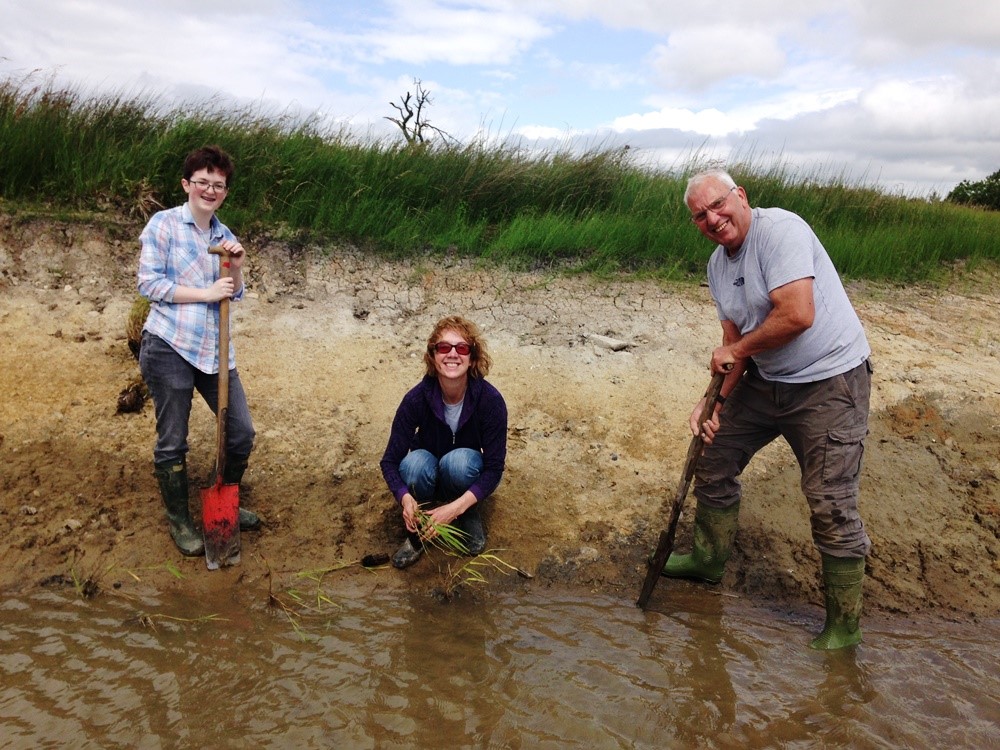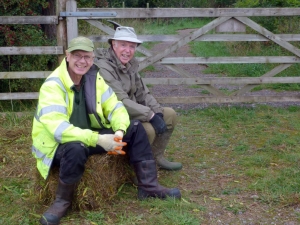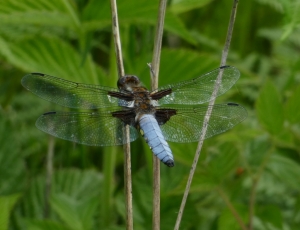Blog Archive (30) Posts Made in May 2015
Spring Colours
Sunday, May 31st 2015
Spring flowers are still showing their colours around the reserve. We have several species of Forget-me-not recorded but as they have not yet been examined closely they are noted as Forget-me-not sp! Their blue colour stands out amongst the grass.
Dandelion like flowers can be hawkbits or hawkweeds, rather difficult to identify at times. One that we do know and it is easily recognised is Mouse-Ear Hawkweed. The underside of the flower is tinged red. We have not worked out why it is called 'mouse-ear''.
Gorse can be invasive and can prevent other plants from growing, so during the winter, areas are cleared allowing other plants to flourish. This year it has flowered exceedingly well. its bright yellow flowers can be spotted from a distance. Some insects are using the flowers as a source of food whilst others sit and await their prey.
Bluebells are indicators of ancient woodlands. I wonder what our far moor looked like covered in trees. The Bluebell bank can now be seen from the red route since the conifer plantation was felled. Close up it is spectacular.
Eco Club and Middle Moor
Saturday, May 30th 2015
Thankfully the weather looked at the diary and changed its very wet forecast to a dry one, just for Eco Club! With the help of model eggs, the children were shown how size, colour and shape varied between species. Food chains were discussed, with Blue Tits eating the caterpillars and greenfly found on plants, but then being eaten themselves by predators like Sparrowhawks. After this introduction we headed out to the nest boxes where there were still chicks to ring.
Details of species and age were given before the chicks were ringed and carefully returned to the nest. The children were able to see Blue Tit, Great Tit and Coal Tit chicks.
Thank you to everyone who helped today.
The middle moor is growing well despite the cold and the wind.
We have already checked that Yellow Rattle is growing, not only from the plug plants of last year, but the seed scattered in the autumn. The next exciting development is the flowering. With careful examination we found one in flower.
Joining the increasing list of flowers in this habitat is Bird's Foot Trefoil.
Half Term Activity Morning
Friday, May 29th 2015
Ten children joined us this morning despite the rain for our Half Term Activities. First we headed off to the pond dipping platforms where we discovered what animals live hidden in the depths of the Foxglove ponds. Great Diving Beetle larvae, Tadpoles and large Stickleback were amongst the finds.
We then headed to the outdoor classroom where, using the examples nearby, we learned about the different ways to help wildlife in gardens by building log piles, bug hotels and hanging nest boxes. The children unearthed a multitude of bugs and beasties as we looked under the logs learning how many of these creatures recycle nutrients into the soil, playing an important part in the food chain.
Pathway Maintenance
Thursday, May 28th 2015
Strimming is an important job through the spring and summer months, ensuring that paths are well defined, clear of long vegetation and easy for visitors to walk down. Mike and Tony spent the morning working their way around the woodland walks clearing long grasses.
By the time they finished the walks were looking much smarter and definitely easier for visitors to follow. The afternoon was spent re-visiting some of the many nest boxes around the reserve to ring any of the chicks before they fledge.
Thank you to our volunteers, who have done a fantastic job on the reserve.
Recording
Wednesday, May 27th 2015
The moth trap had been set overnight and the grand result this morning was two moths in the trap and a micro moth on the wall of the Field Centre. Flower recording gave much better results with over 40 species noted.
Rowan has a creamy white blossom and a sweet scent. The ripe berries of Rowan or Mountain Ash as it is called in the north, provide food for Blackbirds in late summer.
Dogwood just passed the 'flower test', with flowers that were actually open, just.
Whitebeam has been in leaf for several weeks with the flower buds that were closed, but now open.
It was a cold walk across the moor and there were not many insects on the wing. This Green Veined White was hanging on tightly to grass, but was being blown around the stem. The close up photograph shows its eye, antenna, legs and furry body.
Once we were in the centre of the reserve we were sheltered from the biting wind and the sun came out so we were a little warmer. But the insects still held close to the vegetation. A Blue Tailed Damselfly was the first to be seen this year.
CES 3, Volunteers and Spring
Tuesday, May 26th 2015
Usually early mornings for CES begin with a comment on the weather, the cold, the dawn or the frost, but today a different start. Were aliens looking at Foxglove and wondering what all the people were doing at 0415 this morning?
Now back to reality. The forecast for the remainder of the week is for strong wind and some rain so as today was calm and warmish, CES 3 was carried out. It is one of the quietest of the twelve days of CES as most of the females are sitting on eggs and many of the males are singing and guarding territory, so do not move around much. During the time the nets were up, ten and a half hours, over 100 birds were processed, including our first juveniles, a Robin and a Dunnock. By the time we do CES 4 there should be many more. Nuthatch, Bullfinch, Song Thrush, Willow Warbler and Chiffchaff all made an appearance in the ringing room, where a nearly all lady ringing team were hard at work!
Tuesday volunteers were working and carried out a variety of jobs, from checking more tree tubes to trimming a hedge, intersperced with hunting for insects and bugs, especially as the temperature warmed up this afternoon.
Ladybirds, shield bugs, bees, butterflies and numerous tiny insects were all recorded. Nature is amazing at this time of year. Spring is so special as the cycle of life unfurls. This insect managed to fly nimbly amongst the Hawthorn buds, without falling over its antennae! When the photograph was enlarged on the screen it can be seen to be furry all over! ID is ongoing.
Bluebells a real spring flower, are flowering in many parts of the reserve. They are to be found in large quantities along Risedale Beck and on the moorland, but if you look under some trees and in semi shaded areas they can be seen there too, sometimes only a few but their blue colour stands out against the bright green grasses.
A huge thank you to all the volunteers who continue to work hard to make Foxglove the very special place it is. Visitors make comments as to how helpful and friendly the volunteers and reserve managers are, how good the reserve looks and just generally how good Foxglove is! Thank you and well done.
When the Sun Comes Out
Sunday, May 24th 2015
The Sun came out this afternoon and so too did the insects. Large Red Damselflies enjoy the sunshine along Risedale Beck and sit on the Nettles waiting for prey.
There are plenty of weevils around, varying in colour from green to bronze and just plain brown.
A green beetle. This poor beetle has been renamed several times as we attempt to find its correct ID. We are still looking! Usually it can be found in great numbers on Alder leaves but at the minute, just to keep us on our toes, it can be found on nettles, grass and bridge rails.
And of course the butterflies come out to feed in the sunshine, this one on Bugle.
The bird ringers are continuing to check nest boxes. Today this photograph of an owl chick was taken. I wonder what it is thinking?
As all the data is collated and entered into IPMR, it is amazing what we are finding out. A Tawny Owl still with 2 unringed chicks at High Feldom was first ringed in Folly Plantation, Feldom on 27.05.1998 as a chick and has never been seen since. This is the first time it has been caught again. It is not a record but it is certainly a good age!
Thank you to all the bird ringers who are working so hard to check the boxes and ring all the chicks.
May Flowers
Saturday, May 23rd 2015
Flowers are blooming across the reserve. Hidden away amongst the leaves, some Hawthorn flowers are just beginning to open.
Out on the moor, a patch of dark blue needed to be investigated. It was a milkwort, exact species is still to be confirmed. As it is on the edge of the path, another cross will have to added to the map 'Do not strim here please.'
Also on the moor Lousewort is thriving. It is semi parasitc on grass.
Red Clover is showing its pink/red flowers in the green sward of the middle moor. This is an important flower for some bees.
Tormentil is a low creeping perennial that can be found in many places on the reserve, including the moor.
Wildfowl Feeding Platform
Friday, May 22nd 2015
The contractors have now finished work on our new Wildfowl Feeding Platform. The work has been completed to a high standard and was made possible by a generous grant from Yorventure.
Visitors have been enjoying the new view down on the lake, spotting Tufted Ducks, Moorhen and Grey Wagtails, amongst other species. The area directly in front of the platform has been seeded and will soon become a lush green feeding area for the ducks and geese that make Foxglove their home.
Team Thursday
Thursday, May 21st 2015
Work on the waterfowl feeding platform and boardwalk is now nearly complete. The new path gently meanders through Larch trees ending in a viewing area above the lake. The contractors have done a really smart job here; we are really excited to see the project finished tomorrow. Volunteers were working in this area this morning to make sure that there were no obstructions along the path from low hanging branches and to prune back bushes around the viewing platform.
Once clear we moved into the scrapes to continue weeding out invasive willow, Silver Birch and Brambles that have grown in this wetland habitat, allowing for a more diverse ground flora to develop.

Thank you to everyone who has helped us with these jobs.
Nest Boxes
Wednesday, May 20th 2015
Spring is an incredibly busy time for the bird ringers as they visit nest boxes across the training area to survey and ring the nesting populations of Tawny Owls, Kestrels and several other smaller species. Last night the first brood of Kestrel chicks were ringed.
Volunteers have been helping members of the ringing team on the reserve over the past two days as all of the 135 nest boxes on the reserve were checked.
We have found that there is huge variation in the development rate of nests this year. In some nests we have found large chicks not far from fledging, 17 have now been ringed on the reserve, while some birds are still collecting material and building their nests. These Blue Tit chicks were newly hatched in one of the boxes, and over the next three weeks will grow and develop their feathers ready to leave the nest.
Thank you to all the volunteers and ringers who have helped with this.
Stones and Saplings
Tuesday, May 19th 2015
The wildfowl feeding platform and boardwalk is making good progress and will soon be complete.

To help the vegetation on the feeding area regrow; we are going to seed it with grass and wildflowers. The ground is quite rough so before this could be done the volunteers set to work removing all the stones from the area below the platform and levelling out the ground. It is hoped that it is now flat enough that we will be able to mow it once the vegetation grows. Three trailer loads of stone were removed which made a great difference.


Once all the stones had been removed, the volunteers then continued their hard work, removing birch and willow saplings that have been slowly encroaching on the reedbed and scrape areas.

Thanks very much to our volunteers for all the hard work carried out today.
Marsh Tit
Monday, May 18th 2015
More news has come out about our record Marsh Tit, this time in a blog post on the BTO Demog Blog. It has been fantastic to see such interest in this story, with many conservation social media feeds sharing the story across Twitter and Facebook. The story even made it on to the local ITV news, as well as in the local newspapers.
.jpg)
Bodgers and Owls
Sunday, May 17th 2015
The Foxglove Bodgers were at Foxglove today. These skilled woodworkers could be found outside the workshop, turning wooden bowls on medieval style lathes and making stool legs, using green wood cut from the reserve itself. Visitors were able to try their hand at these tasks and learn from the experts.
The workers who have been creating our wildfowl feeding platform have made good progress over the week. Next week hopefully they will be able to complete the task and visitors will be able to walk along the boardwalk to look upon the lake.
The Foxglove Tawny Owl chicks were ringed this afternoon, now that they are getting big. It is pleasing to see that the pair have managed to rear four chicks.
Birdsong Breakfast
Saturday, May 16th 2015
Twenty six visitors joined us at 5am this morning for our annual Birdsong Breakfast. The groups were split in three and enjoyed an hour walking around the reserve, listening to and learning about birdsong and the birds found at Foxglove. Highlights included stunning views of Redstart sitting high in a Scots Pine, and views of the Green Woodpecker near to the wetland.
Following this the group returned to their cars and we headed across the training area, where we were treated to good views of Black Grouse. A Whinchat was also seen at one location; here some were lucky enough to hear Grasshopper Warbler singing. Breakfast at Wathgill followed; as usual this was top notch.
Well done to everyone for getting up so early, and to everyone who helped by leading the walks.
CES 2
Friday, May 15th 2015
With high winds forecast over the weekend and into next week, the second of the CES ringing days began today at 5am. Several of the bird ringers came in before work to help erect the nets and returned again at the end of their day to help finish processing the birds and to take the nets down.
By the close of play 93 birds of 23 species were caught, including this female Kingfisher.
A male redstart was also caught. These birds were absent from the ringing room last summer so it is brilliant to see them back on the reserve. The birds caught were typical of the second CES day, with many more males caught as females are now incubating eggs.
Thank you to all the ringers who put in time today, and all those others who delivered food, made tea and helped out.
Wednesday Work
Wednesday, May 13th 2015
Work is progressing well on the new waterfowl feeding platform alongside the lake. The base of the platform has now been constructed and you can get some idea of the beautiful views across the lake that our visitors will be able to enjoy.
The base of the boardwalk is going in well, with gentle sweeping curves between the Larch trees.

Butterflies were seen in good numbers as they made the most of the warming sun. This female Orange Tip was seen mating and then laying her eggs on Cuckoo Flower, the larval food plant of this species.

Tony has been working hard around the reserve, spending the morning clearing drainage pipes, before heading out with a mower to cut along pathways and net rides to get the site ready for the second of the CES bird ringing days this Friday.
Thank you to everyone who has helped on the reserve today.
Please note that there is an error on the Fruit and Vegetable Quiz Sheet. Question 19 should read 7 letters not 6.
Team Tuesday
Tuesday, May 12th 2015
Volunteers have had a busy day on the reserve completing a variety of different tasks. Firstly, a small group headed off along Risedale Beck to clear a section of stream that had become clogged with woody debris following the high water levels over the weekend.
They worked hard, dragging the twigs and branches out of the water allowing the stream to flow freely once more.
The stone gabion cages were revealed as the debris was cleared. These were originally constructed to help control the flow of water out of the reserve and minimise damage to the fence. Since then the water has re-routed itself around the gabions, leaving them perched on the bank. Now out of the water they are used by many different animals for shelter and we frequently record signs of Otter in the soft mud at the entrance.
Our other volunteers found themselves continuing with the job of checking the many tree tubes around the reserve. To do this we lift the tube up, check the tree is alive and there are no signs of disease, before weeding any grasses or other plants from around the base. This important job helps to maintain the health of the young saplings, giving them the best chance of survival.

All of the hard work was rewarded with some delicious coconut buns from Anne at break time.

Our thanks go to all those who have helped us out with these jobs.
Marsh Tit Longevity Record
Tuesday, May 12th 2015
The Marsh Tit caught on the first CES day of the year is causing quite a stir, as it holds the longevity record for this species in the UK. There is a good article on this in the Northern Echo and shortly will be one on the BTO Demog Blog.
This bird (ring number R084872) was first caught in July 2004 as a juvenile bird, and since has been caught 43 times. This is a fantastic record for the reserve to hold and highlights the hard work and care taken by the ringing team and volunteers who help to maintain the reserve in such good condition.

Wildfowl Feeding Station
Monday, May 11th 2015
Foxglove has managed to secure a grant from Yorventure to create a wildfowl feeding platform. A stretch of boardwalk will be constructed on the North West side of the lake, which will meander down through the larch woodland to a feeding platform overlooking the lake.
This was the first day of the construction work, which is expected to take a couple of weeks. By the end of the day visible progress had been made. Hopefully soon visitors will be able to look down over the lake and feed the wildfowl found there.
Whilst out in the woods today unblocking drains we also found some attractive fungi.
Species Recording
Sunday, May 10th 2015
Weather and a nesting Blue Tit have curbed the moth trapping so far this year. Butterfly surveys have been carried out when the weather has been warm and sunny.
On Friday five species were recorded. Twenty Orange Tip butterflies were counted, nine Green Veined White and two Brimstone. Some of the Peacock butterflies are looking a little worse for wear as they have spent the winter in hibernation. Others look pristine as they sunbathe.
Speckled Wood butterflies have recently taken their place on the observation board.
Monthly flower walks continue throughout the seasons, only a good covering of snow curtailing these walks. A recent addition to the monthly list is Cuckoo Flower, known also as Milkmaids and Ladies Smock. It is beginning to show its delicate pink/purple flowers throughout the Scrapes.
Barren Strawberry has been in flower for several weeks and as its name suggests it does not produce a fruit. Wild Strawberry, on the other hand, does. They are just beginning to bloom. For some reason a close eye is kept on the places where these flowers are. I wonder why?
Jack-by-the-hedge was growing near the Field Centre three year ago but has never been seen there since. Several stems have been found around the Bullet Catcher area.
Totally Unrelated
Saturday, May 9th 2015
As spring moves forward slowly there are more and more and even more species and views to be photographed, so choosing what to put on the blog can be tricky. After deliberation the field was narrowed down, but with little to make a cohesive story, so hence the blog title 'Totally Unrelated'.
This time of year is extremely busy for the bird ringers, as on many evenings they are out checking bird boxes on the training area. If the chicks are old enough then they are ringed but often the larger chicks can have their ring fitted, but a return to the box is needed, to ring the smaller chicks. There is a narrow window of time when the Tawny Owl adult can be caught at the box. This requires stealth and skill, but if caught then a great deal of data can be gained, as has already been reported on the blog. Once the chicks are old enough to keep themselves warm the adult owls only return with food.
The welfare of the birds is always paramount, but whilst the chicks are returned to the nest there is time for a photograph of the adult and the amazing beauty of the Tawny Owl can be appreciated.
Tawny Owls are usually the first birds to have their young, followed by the Jackdaws and Kestrels. A nest of Kestrel chicks has been found. One egg was still to hatch and as they were so young the box will be returned to in a few days time.
Whilst out on the training area this morning the ringers were lucky to see a Green Hairstreak Butterfly. Although this is a widespread species, it often occurs in small colonies and has undergone local losses in several regions.
Early Purple Orchids have been reported on other sites but so far none had been recorded at Foxglove, but success, they have not disappeared, they have just been shy!
On leaving the reserve, just after the wooden sign, lift your eyes from the road, probably best to stop the car first! You will be rewarded with an Apple tree in full blossom.
Whilst some flowers are in full bloom and some still in bud, those that flowered early in the spring are now setting seed. This is a Coltsfoot seed head.
First - 'And finally'. Walking around the reserve a Roe Deer Buck was observed. Looking carefully at the shape of his antlers, there is a possibilty that this is a yearling buck. He was very co-operative and stayed still to have his photograph taken before melting away into the undergrowth.

Second 'And finally'. As can be imagined after the heavy rain last night most plants were covered in water droplets. This droplet opens up another little world.
Spring Sightings
Friday, May 8th 2015
To the delight of our volunteers, Moorhens have been using the nesting platform that is floating in the middle of the lake. Visitors have been keeping a keen eye on the development of the nest and yesterday we were lucky enough to see the chicks take their first jump into the water. In no time at all the adults had them hidden away in the thick vegetation around the water’s edge.

Large Red Damselflies were seen on the reserve this morning, the first sighting of the season. These damselflies can take up to three years to grow into mature adults; during their development the larvae typically have 11 growth stages. Unusually for dragonflies, the larvae are aggressive and display territorial behaviour.

Next weekend is our Birdsong Breakfast, for this fantastic event we meet at the Field Centre at 5am before heading around the reserve on a guided walk to enjoy the dawn chorus. We will also be visiting a nearby Black Grouse lek before heading to Wathgill for a cooked breakfast. This is one of the few events we charge for (£5) and there are still spaces available. If you would like to book on this please contact the reserve managers on 01748 831113 or visit our events page.
Good News!
Thursday, May 7th 2015
As we were checking the remaining owl nesting boxes this afternoon we stopped to have a look at the wild bird seed crop that was planted a few weeks back. There is good news to report back, the seeds have germinated; the bare soil is speckled with fresh green seedlings. As these grow they will provide a variety of food sources through the year. Insects will visit the flowers before birds feed on the seed in the late summer and autumn. We will keep you all posted as to how this project progresses.
In one of the boxes we visited earlier, we found a Tawny Owl sitting, with four young chicks. It is very unusual for there to be a clutch of this size, more normally you would expect to see two or possibly three. The chicks are currently too small to ring but we will be re-visiting the box once they have had a chance to grow. The adult was first ringed while she was nesting in the same box two years ago.
Dippers
Wednesday, May 6th 2015
After an evening out checking nest boxes some of the ringing team were up early to re-visit a Dipper nest. The four pulli were about one week old, and large enough to ring. We were also lucky enough to catch the adult male as he flew up and down the river finding food. As the net was taken down he was once again delivering food to the nest for the awaiting chicks.

A Wet and Windy Day
Tuesday, May 5th 2015
Today ten volunteers were busy tending to the young trees at Foxglove. Many of these are protected by plastic guards to allow them to grow without being eaten by deer.
Each year the guards have to be lifted to clear the vegetation that has grown around the base of the trees. This morning was very wet, but despite this, the volunteers worked hard and managed to clear the guards on a large area of trees.
Two of our volunteers went out with loppers to clear any overhanging low branches from the woodland trails. An interesting find along the way was the first Striped Ladybird of the season.

Thank you to all the volunteers who braved the rain to help today.
First CES of 2015
Monday, May 4th 2015
Today was the first CES (Constant Effort Site) day of the year. The same nets are raised for the same length of time on 12 specific days between May and the end of August. Ten and a half hours is the period of time that the nets are raised, so the bird ringers were at Foxglove at 0530. A beautiful but cool dawn surrounded them as they raised the nets.
Winter still has its grip on the reed bed but new green shoots are beginning to appear.
Hints of green can be seen around the pond and across the coppiced area.
Blackcaps have been heard on the reserve and 2 males made an appearance in the ringing room this morning.
A Garden Warbler was also caught.
By the end of the day over 200 birds had been processed.
CES does not just happen, it requires commitment not only from the bird ringers but from those volunteers that help by providing cake and sausage rolls and of course numerous cups of tea. A huge thank you to everyone.
Among the many birds processed were 29 Bullfinches, 23 Willow Warblers, and believe it or not a Marsh Tit that was first ringed at Foxglove on 10 July 2004 as a juvenile. This makes it the longest lived Marsh Tit recorded in the UK and N Ireland. It is a couple of months off the oldest Marsh Tit ever recorded anywhere. It has been trapped 42 times on the reserve which says a lot for the way the birds are handled by the ringers whilst in captivity.
A note just arrived from Jack on Salisbury Plain:-
Hope you managed to get out today I had a disaster. With weather forecast looking good set out at 03.45hrs, Out of the car I was greeted by strong wind and then it started raining, so had to go home very disappointed. Anyway managed to get out nesting and found my first Whitethroat and Blackcap of the year. After some time eventually nailed the Stonechat nest with freshly hatched chicks.
Spring Continues
Sunday, May 3rd 2015
As has been said before it is very helpful that trees do not move around! Careful examination has helped us sort out the male and female Holly trees. The females have berries, the males do not. The male Holly trees have buds which will soon open.
Another tree in flower is the Dogwood, found behind the easy access hide. You can just see the buds peeping out between the new leaves.
Hawthorn has been slow to come into leaf and there are still some trees with leaves only partly unfurled. During the coppicing of the willow carr, Hawthorn trees were given some 'tlc', these are now beginning to grow new young shoots. It was a surprise when the flower buds were noticed on one shrub. Possibly we will soon be able to 'cast a clout'?
As the nest boxes are checked so the data is entered into IPMR. It has been stated many times that our data base contains a great deal of information. More news of the owls, caught on Friday has been reported.
The owl breeding in Wathgill Camp has been breeding in the same box since 2007.
The owl breeding in a box on the Training Area was ringed as a chick by Sophie in FGC, in Box 8 in 2013!
All in a Day’s Work
Saturday, May 2nd 2015
After the winter work is completed, we keep a check to see what happens next. An area near the head of the lake received attention, with trees pollarded, some were felled and Blackberry stems removed. This work was carried out to help the Bluebells that grow there. It has been a success as the Bluebells are now flowering.
Many flowers can now be seen on the reserve. Non-flowering plants are also growing. Horsetails are producing their fruiting bodies, which release spores. The ancestors of these plants produced our coal seams.
Ferns are unfurling their fronds.
The bird ringers were out again last night checking the larger nest boxes. Although bitterly cold there was a beautiful sunset with accompanying sundog.
Sun dogs (or sundogs) are mock suns or phantom suns. The scientific name is parhelia (singular parhelion), They are an atmospheric phenomenon that consists of a pair of bright spots on either side on the Sun, often co-occurring with a luminous ring known as a 22° halo. They are created by light interacting with ice crystals in the atmosphere. (We could not see the halo.)
At the last stop, as two plump Tawny Owl chicks were ringed and carefully returned to their box, a Woodcock flew over, roding ( the Woodcock's display) and a Grasshopper Warbler was heard. By then the moon had risen.
Nest Box Update
Friday, May 1st 2015
Spring is a very busy time for the bird ringers, who have already spent many evenings out and about on the training area checking the many Tawny Owl and Kestrel nest boxes. The team will be out again tonight re-visiting some of these boxes where chicks can be found.
So far we have had some interesting results from the re-trapped adults. One Tawny Owl was ringed in 2006 and has been breeding in the same box ever since. Another was first ringed as a chick, at Hudswell Grange in 2007; this is the first year she has been seen since then and was found in a different box to the one she was first ringed in. We have also had a Kestrel that has been recorded breeding in the same box for the last three years.
This just shows a small portion of the valuable information that the ringers collect and send off to the BTO. All of this is then used by the BTO to monitor population trends and to help shape conservation policies protecting these beautiful species.



















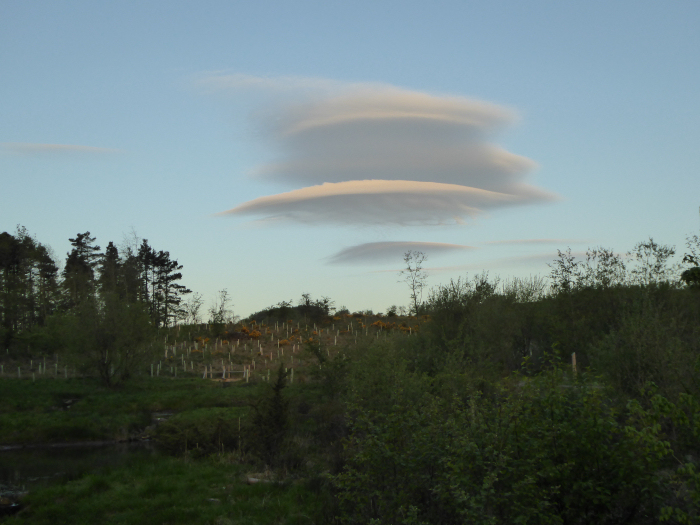
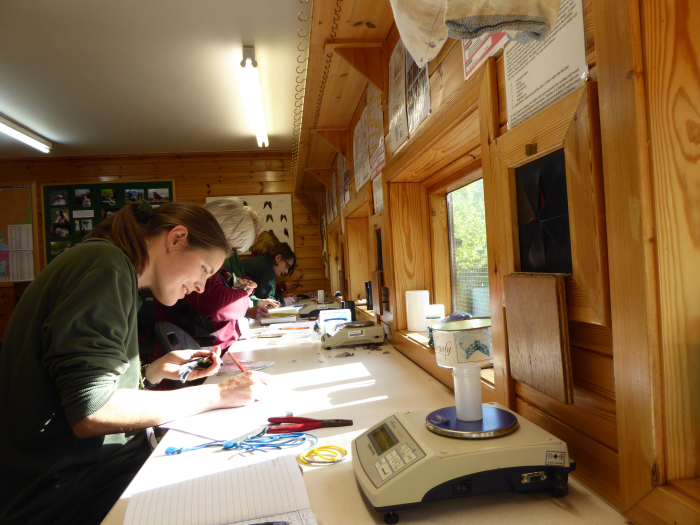
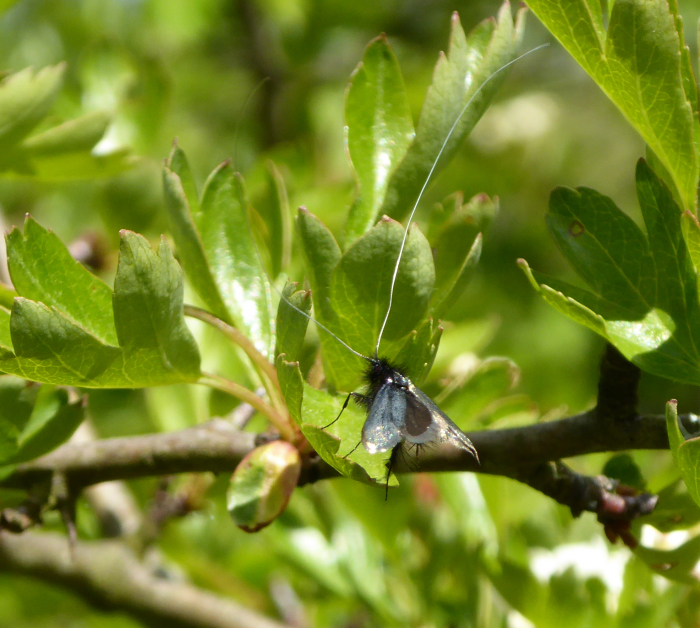
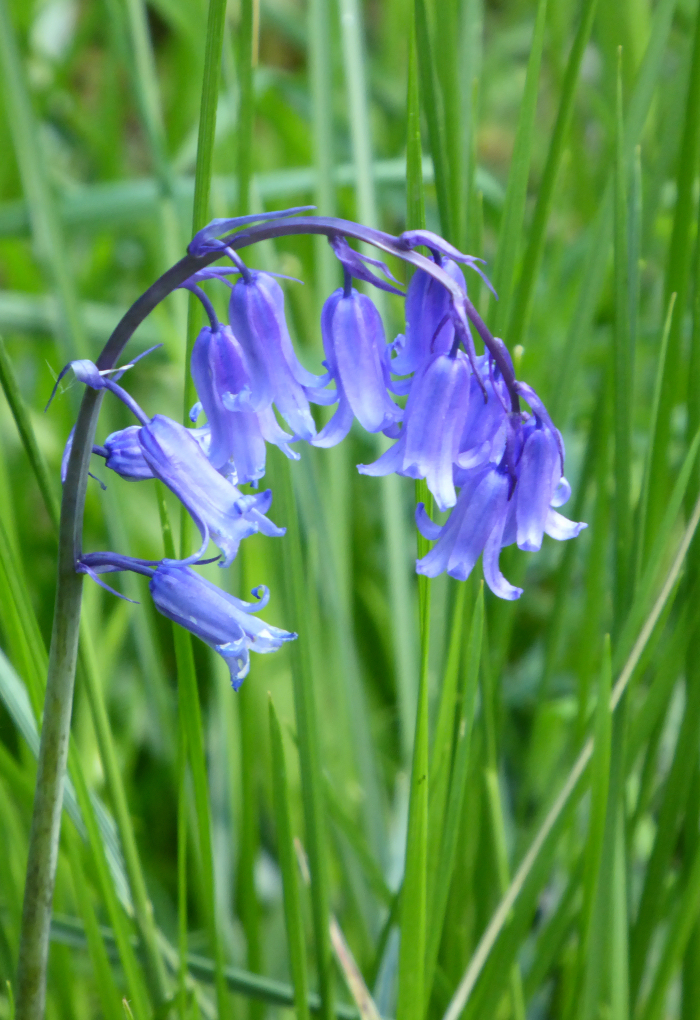







.JPG)












.JPG)







.JPG)
.JPG)
.JPG)
.JPG)











.JPG)



















